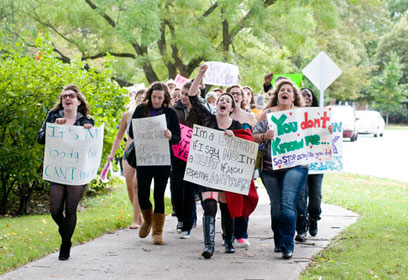Here’s the thing to remember about “yes means yes”—the “affirmative consent” standard for college campuses that requires all partners to give “affirmative, conscious, and voluntary agreement” to a sexual encounter and every part thereof: the policy comes into play only when there is a dispute about whether a sexual assault took place.
With or without yes-means-yes, joyous, enthusiastic, affectionate sex will keep on spreading its lubricious glory over unlaundered dorm room sheets and secluded quadrangle lawns. Good sex will transpire far from the offices where yes-means-yes is adjudicated.
So forget all the bubbly talk about how affirmative consent promotes women’s sexual agency and the mutual exploration of desire. Also forget how affirmative consent will criminalize what loving couples do every night of the week.
Yes-means-yes will not encourage good sex. It will not discourage good sex. It is irrelevant to good sex.
The new standard applies to bad sex: intercourse while strong arms hold down weaker limbs, fellatio enabled with date-rape drugs, groping engaged in deadened, drunken unconsciousness.
But even many of the policy’s supporters admit it will not prevent this kind of sex either. That’s because nine-tenths of sexual assaults are committed by the same repeat offenders. These guys are not confused about whether the woman said yes or no. Eighty percent of their assaults occur when the victim was so stoned she couldn’t say either. They know they are raping. A shifted standard of proof from “she didn’t say no” to “she said yes” is unlikely to change their actions.
“In real life . . . here’s the difference the new standard will make,” Katha Pollitt writes in The Nation. “Not much.”
Still, yes-means-yessers say the law, which is being adopted by states and academic institutions nationwide, will change the culture. It may do so. The question is how.
Elizabeth Stoker Bruenig, in these pages, made an interesting argument that feminists are torn between their shared view that sex is something you do for fun and their intention, represented by this new code, that it be pursued in a gravely thoughtful matter.
But individual feminists are not torn. Feminism is split—on the meanings of sex and gender, on what to do when sex is a problem, and even on what counts as problematic sex. The split is old as feminism. Parsing it can expose the historic roots of the current policy, the contradictory visions it embodies, and the regrettable consequences it may bring.
There are lots of ways to describe this divide. One is social constructionism versus essentialism. The former holds that regardless of genitals and chromosomes, gender is mutable, so all sorts of social arrangements are possible, including equality—and an end to sexual violence. The latter, basically, holds that biology is destiny. Where sex is concerned, the essentialist view of biological destiny is pretty grim. “By anatomical fiat—the inescapable construction of their genitals,” Susan Brownmiller wrote in Against Our Will (1975), the foundational text of the essentialist anti–sexual violence movement, “the human male was a predator and the human female served as his natural prey.”
If that’s true, there’s only one thing to do: protect women.
In the early 1970s, some women learned karate, stationed themselves on street corners to watch over their sisters, or checked out on men altogether and moved to women-only communes in Vermont. But feminists were also, rightly, angry about sexual violence. And anger demanded more than safety.
For some women, anger cried out for retribution. Police guns were stronger than karate chops, legislatures more authoritative than consciousness-raising groups, and prisons more protective (or so it was thought) than self-imposed exile. By the 1980s anti-violence feminists were in bed with law-and-order Republicans.
Yes-means-yes is part of that tradition.
Protect-and-punish is not particularly sexy. And, indeed, sexual pleasure has never been high on the anti-violence agenda. In fact, contra Bruenig, who finds it “a strange season when [conservative Christian] culture warriors and women’s studies departments find common cause,” feminists of a certain stripe have been palling around with Christian sexual moralists for a long time.
One such alliance was the Social Purity movement of the mid-to-late nineteenth century. In 1875 feminist paragon Susan B. Anthony delivered a major speech railing against the “twin [masculine] vices” of “drunkenness and licentiousness,” under whose influence husbands subjected “sober, virtuous woman” to physical brutality and “spiritual [read: sexual] shame and humiliation.” Anthony and the feminist Social Purists were not campaigning for women’s sexual pleasure or freedom. “The fire in the furnace should drive the ship over the waves”—that is, be put to more productive uses—“not burn it to the water’s edge,” her comrade Frances Willard declared.
Poverty drove women to prostitution, Anthony said; “abnormal passion” drove men to the brothels. Men’s rapacious desire and the “monster social evils” it created would be reined in only by prohibition and the abolition of prostitution. As antidotes, Anthony proposed education and economic independence for women—not what her Christian friends had in mind—and temperance.
Over the centuries, conservative feminism has given us many versions of male sexual vice and female victimization—pornography is violence against women, sex work is “trafficking,” intergenerational sex is rape—predicated on a gendered power imbalance they believe so intractable that only legally imposed discipline can rectify it. Elizabeth Bernstein, a feminist critic of this mix of gender essentialism and lock-em-up moralism, calls it “carceral feminism.” Whatever you think of its values, it hasn’t been particularly effective in wiping out violence.
But not all American feminists have been out to purify and punish. While Anthony and Willard were spitting brimstone, Victoria Woodhull and, later, Emma Goldman were singing out for free love. Free lovers leaned toward anarchism and libertarian socialism; they were not big on vice laws and prisons. For instance, in 1872, when Woodhull ran for president on the Equal Rights Party line, her platform included abolition of the death penalty.
So it is disconcerting when the “sex-positive” heirs of Woodhull and Goldman embrace yes-means-yes. On the New York Times op-ed page, Gloria Steinem and Michael Kimmel applauded yes-means-yes by quoting James Joyce’s Molly Bloom and anointing its word-heavy way of making whoopee “clearly saner—and sexier.”
A few of weeks later, I heard the same attitude expressed during a panel at Hunter College, on the eve of the adoption of the policy by the City University of New York, which includes Hunter. Two panelists could be expected to applaud the policy: CUNY Deputy General Counsel Jane Sovern, who lobbied for its adoption, and Hunter’s undergraduate president, Colleen Cash, who invited students to stop by what sounded like a cross between an extracurricular club and the Manhattan Criminal Court to chat or, as she added cheerfully, “report!” The third panelist, Jacob Boersema, a sociology fellow, didn’t opine, but he’s Dutch and, it appeared, a little stunned by the whole thing.
The fourth speaker was the journalist Nona Willis-Aronowitz, daughter of the freedom-loving feminist and consummate skeptic Ellen Willis and the anti-authoritarian socialist and labor scholar Stanley Aronowitz. Willis-Aronowitz tended to talk about yes-means-yes more as a cultural phenomenon than a legal one. She first encountered the term, she says, as the title of a 2008 anthology edited by activist-writers Jaclyn Friedman and Jessica Valenti, which focuses more on sexual pleasure than legal penalties.
Willis-Aronowitz described a sex-ed program at Colgate College, also called Yes Means Yes, where “students sat around talking honestly about sex”—what they like, what they fantasize. “It was almost utopian,” she said approvingly, an echo of her late mother. Boersema agreed with her that America sorely needs a more “sex-positive” culture, and Willis-Aronowitz suggested that the law would serve that goal. How? She didn’t say but seemed to endorse it anyway.
Laws can change social conduct even before the values they encode are fully accepted. Think school integration after Brown v. Board of Education (1954). But intimate conduct is notoriously resistant to legal intervention. People keep selling and buying sex, or desiring same-sex bodies; women have abortions at the same rate whether it is legal or illegal.
Moreover, the intended beneficiaries of an anti-vice law often become its victims. Nineteenth-century anti-prostitution ordinances rounded up working girls, not their clients. The laws promulgated by Social Purist Anthony Comstock with feminist assent put Margaret Sanger in jail for disseminating birth control pamphlets.
Even aggressive prosecution of interpersonal violence with real victims can have unintended consequences. As “abolition feminist” Beth Richie lately exposed, the Violence Against Women Act has intensified the surveillance and criminalization of the already over-policed, including women of color on public assistance. Mandatory arrests at domestic violence scenes, for instance, may result in the removal of children because their mother failed to shield them from witnessing her own abuse.
Like VAWA, affirmative consent laws represent a fantasy of a benign state—or in this case, state-funded institution—innocent of self-interest, racism, or class bias; an ideal state that is not itself a violent actor with the power to seize liberty or life.
It also represents a feminist utopian idea—in a sense, the feminist idea: that each woman, like each man, owns her body, its privacy and its pleasures. But yes-means-yes the policy—especially backed up by the federal initiative requiring academic institutions to enforce stringent anti-rape policies or pay the price—is rooted in a dystopian, even vengeful, vision of gender.
In trying to eradicate masculine violence, yes-means-yes also enacts the masculinist ideology that might is right. To ensure the free exchange of caresses, it applies the whip and the chain.








